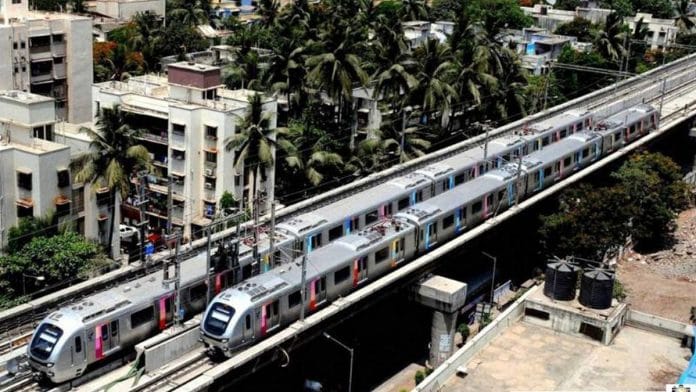Mumbai: A cacophony of auto-rickshaws, haphazardly parked vehicles, hawkers and throngs of pedestrians. This is what areas around most railway stations in Mumbai look like.
The city’s development authority is hoping to change all that when primary commuting in Mumbai shifts to the nearly 300-km metro railway network across the Mumbai Metropolitan Region from the dense suburban railway system.
The Mumbai Metropolitan Region Development Authority (MMRDA) in a meeting last month approved a Rs 3,849.38-crore plan to improve areas within a 500-metre periphery of every metro station proposed or under construction and have a multi-modal integration. The plan will be implemented at all 155 metro stations across proposed 12 metro corridors.
“We have consultants conduct a study on 30 metro stations being built along metro corridors 2A (Dahisar to DN Nagar) and 7 (Dahisar East to Andheri East) and prepare a draft plan with a cost estimate. As per this study, the cost of improving station areas in a periphery of 500 metres from a metro station and implementing a multi-modal integration will cost about Rs 25 crore per station,” said Dilip Kawathkar, deputy metropolitan commissioner (admin) and MMRDA spokesperson.
“While we have assumed this estimate for stations of other proposed metros as well, the actual cost may differ from station to station during implementation and could be lower than our estimate,” he added, saying Chief Minister Devendra Fadnavis, while approving the plan at a meeting last month, has asked to minimise the cost as much as possible by prioritising the basic and essential elements of the plan.
Also read: Mumbai building collapse: Should India save its metropolises before dreaming of smart cities?
17 components to decongest metro station areas
According to the minutes of the MMRDA meeting held last month, the development authority has charted out 17 components through which it plans to decongest areas around metro stations and provide for multi-modal integration.
These include widening of pedestrian pathways, building cycle tracks, a pedestrian signal, foot-over bridges or skywalks wherever necessary, have public e-cycles, create parking facilities and bus bays, among others. The plan also includes strictly prohibiting parking on streets within 500-metre radius of a metro station, having demarcated pick-up and drop zones for private vehicles, installing surveillance cameras, signage, area maps and street furniture such as benches, dust bins and water-vending machines.
The MMRDA will also look at an overall improvement of junctions and traffic flow at station areas and re-organise above ground and below-the-ground utilities accordingly.
Incidentally, improving station areas was already a small component of the total budget of all metro corridors approved by the state cabinet with an estimate of Rs 2-2.5 crore per station, amounting to a total of Rs 386.96 crore for 155 stations as against the Rs 25 crore estimated cost now. Officials, however, said the previous estimate only took the technical aspects into consideration for the construction of stations, and entries and exits, while the current plan is more holistic.
Of the Rs 3,849.38 crore required for the multi-modal integration at station areas, the MMRDA is hoping to raise Rs 2,694.57 crore through low-interest loans and fund the rest Rs 1,154.81 crore. There is also a proposal to recover 50 per cent of the cost from the Brihanmumbai Municipal Corporation or whichever urban local body in the Mumbai Metropolitan Region under whose jurisdiction the particular station area falls.
Previous efforts to decongest station areas
The railways, the civic body and the MMRDA had come together in the early 2000s to plan and implement a set of measures to decongest areas around major suburban railway stations under the World Bank-funded Mumbai Urban Transportation Project.
The plan, called SATIS (Station Area Traffic Improvement Scheme), involved construction of additional foot-over bridges, interconnecting and extending existing ones, improving platforms, creating additional space for pedestrians at stations, manage parking and integrate with public bus services.
However, though there were piecemeal improvements by different agencies, the whole plan never took off in its entirety due to differences over planning, cost-sharing and rehabilitation of project-affected people.
Similarly, the MMRDA also planned a station area improvement scheme before the commissioning of the 11.4-km Versova-Andheri-Ghatkopar metro and the Chembur-Wadala monorail with bus feeder services, parking facilities wherever possible and designated place for auto-rickshaws and taxi stands.
The metro stations of Ghatkopar and Andheri, and Chembur monorail station were connected with the adjacent suburban railway stations. However, the MMRDA could not ensure bus feeder services, parking or auto-rickshaw and taxi stands at most metro and monorail stations due to space constraints as the station decongestion plan was put in place not during the planning stages of the metro corridor, but close on the heels of its commissioning.
Also read: This IAS officer is trying to change the perception that Mumbai Metro 3 is a ‘demonic’ plan






